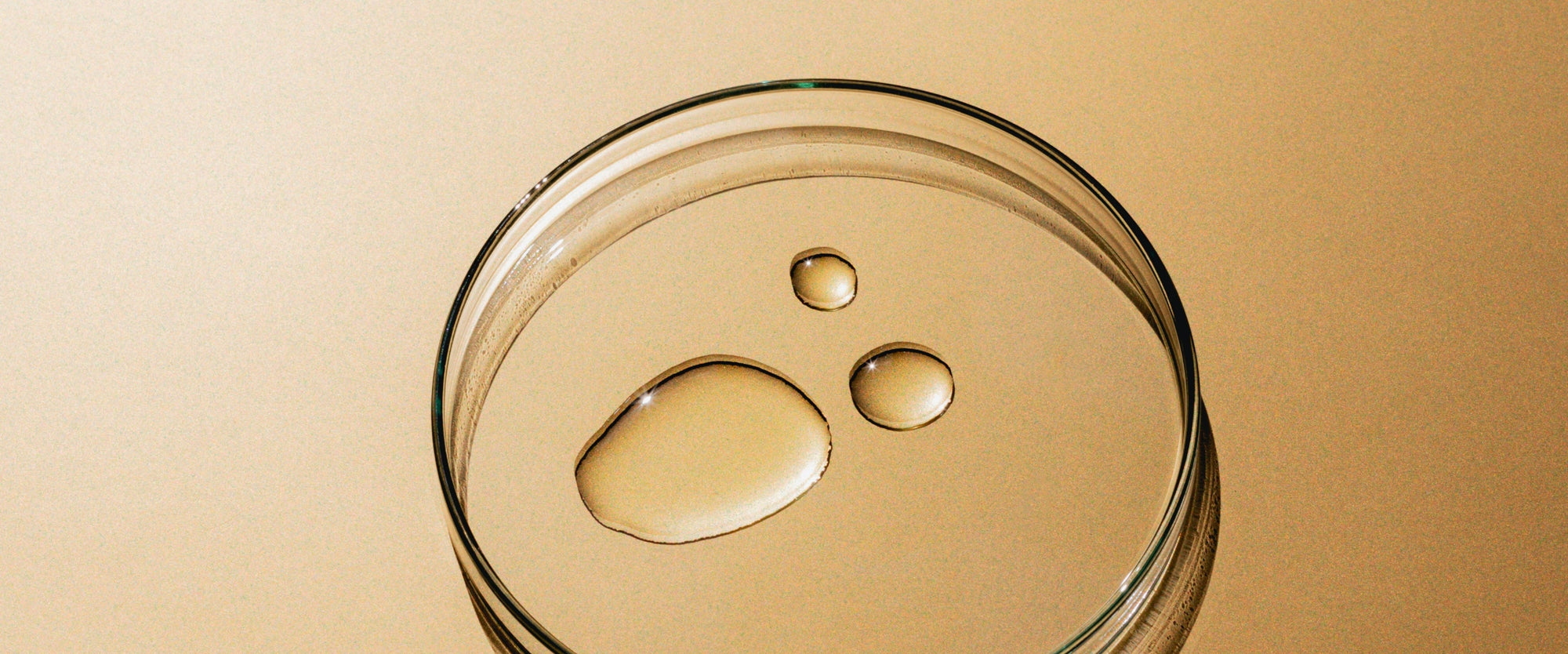

· By Clive Wright
How to Oil Cleanse: The Ultimate Guide
Did you know some cleansers that dry out your skin can actually cause it to overproduce oil? If you think oil and your skin don't mix, you need to try oil cleansing.
The oil cleanse method (OCM) is a skincare routine that uses beneficial oils to deeply cleanse and dissolve buildup in pores, providing nutrients, vitamins, antioxidants, and fatty acids to strengthen and rebuild the skin.
In this TUTTOFARE guide, we’ll break down the science behind oil cleansing, touch on the history, explore the benefits for different skin types, and walk you through a step-by-step guide to achieving healthy, balanced skin.

Understanding the oil cleansing method
Oil cleansing is a skincare method that replaces the need for traditional soap or detergent-based cleansers by using natural oils to cleanse the skin. The oil cleansing method involves the use of oil cleansers, which are effective for a range of skin types, including:
- Acne-prone skin (yes, it works a treat)
- Oily skin (like you wouldn't believe)
- Normal skin to combination skin
- Dry skin
- Sensitive skin
- Sensitised skin
Incorporating oil cleansers into your skincare routine can provide numerous benefits for various skin types. It helps to balance sebum production and strengthen the skin barrier, regardless of skin type.
Wondering about the workings of oil cleansing? We'll explore the principles behind the method and dispel prevalent oil cleansing misconceptions.
The science behind oil cleansing
The science behind oil cleansing is based on the principle that 'like dissolves like'. Similar in nature to how 'like attracts like', it's founded on the idea that things with similar properties typically mesh better together. Like our skin's natural oils and an oil product.
Comparatively, cleansing with harsh soaps or detergents can eliminate the good bacteria in your skin. This throws your microbiome out of balance, creating an environment for breakouts and other inflammation.
Adding good oils to your skin helps counter the excess sebum your skin produces. With oil cleansing, we can effectively dissolve and remove dirt, dead skin cells, pollution, make up, and excess oil from our skin without stripping it of its natural moisture. Oil cleansing keeps your skin's microbiome nourished, in balance and healthy.
The backstory of oil cleansing
The Ancient Romans and Greeks would use olive, sesame, moringa and castor oil to oil cleanse. These oils were processed naturally with little-to-none intervention.
Over the years, high-quality, low-intervention oils have been swapped out for a subset of industrial seed oils, including almond oil and sunflower oil. Industrial seed oils are higher in polyunsaturated fatty acids (PUFAs), which means more prone to oxidation, and having a negative impact on your health and skin.
Ways to oil cleanse
High-quality oils are preferred for oil cleansing because they enhance the effectiveness of the process. As the oil cleansing method replaces dirty oil with a fresh layer of oils, it's important to choose ingredients that impart nourishing properties to the skin.
At TUTTOFARE, we recommend natural cleansers with a combination of high-quality, low-PUFA oils including coconut oil, olive oil, castor oil and jojoba oil. Oil cleansers may also include other nourishing natural ingredients and essential oils for therapeutic benefits.
You may alternatively like to use solid oils or fats to oil cleanse, such as tallow or cocoa butter, however the consistency isn't as easy to work with. These ingredients are also at their best in a more solid form to preserve the integrity of their formulas and carry across the most benefits.
Benefits for different skin types
Oil cleansing benefits all skin types, including oily, acne-prone, dry, and sensitive skin. By choosing the right formula for your skin type and climate, you can enjoy the numerous benefits, including:
- Face lifting and lymphatic drainage
- Improved texture
- Increased blood flow and circulation
- Providing vital nutrients to your skin
- Adding a protective layer against toxins, chemicals, pollutants and weather
- Keeping moisture locked in for radiant skin
- Remove dead skin cells and excess oil
- Unclogging pores and preventing breakouts
By balancing sebum production and strengthening the skin barrier, oil cleansing can help you achieve a healthy, radiant complexion. It's the best way to clean your skin naturally.

Step-by-step guide to oil cleansing
Now that you know the science and benefits of oil cleansing, let's delve into the finer details. A successful oil cleansing routine includes preparing your face, massaging the oil onto your skin, and removing impurities with a warm damp washcloth. Follow the steps below to achieve the best results with TUTTOFARE Cleansing Oil.
Prepare your face
Before you start with cleansing oil, make sure your skin is dry. Starting with dry skin allows the oil to effectively dissolve and remove dirt, makeup, and excess sebum, ensuring a thorough and effective cleansing process.
You can use micellar water, cleansing balms, or makeup wipes to remove makeup before oil cleansing.
Massage the oil
Spread the cleansing oil onto your dry skin, gently massaging it for around 1-2 minutes. Massaging the oil helps to:
- Dissolve makeup and impurities
- Nourish your skin
- Boost blood circulation
- Encourage lymphatic drainage
- Promote a healthy, radiant complexion.
Be gentle and take your time to ensure you’re giving your skin the attention it needs.

Remove impurities with a warm washcloth
Having massaged the oil onto your skin, use a warm washcloth to gently wipe away impurities. Using a warm washcloth helps open up pores, allowing dirt and oil to be removed more effectively.
Steam your face to open up your pores, allowing dirt, impurities, and bacteria to be drawn out. Gently rub the cloth all over your face. Make sure to thoroughly clean the skin. Finally, wipe until it is smooth.
Make sure to use a clean washcloth each time, as reusing washcloths can spread bacteria and dirt from one area of your skin to another, and avoid using hot water as it can cause irritation and dryness.
Repeat!
At TUTTOFARE, we like to recommend double-cleansing, especially if you're wearing makeup. Make sure there is no trace of makeup left on your skin as this will remain trapped when you follow up with a moisturiser.
Common oil cleansing mistakes (and how to avoid them)
Even though oil cleansing has numerous benefits, differing application techniques can potentially lead to skin problems. To help you avoid these pitfalls and maximise the benefits of oil cleansing, we’ll cover common mistakes, such as using the wrong oil formula, insufficient massaging time, reusing washcloths, and using hot water.
Forgetting that dry skin is the first step
It's important to only ever oil cleanse on dry skin to enhance the effectiveness of the ritual. If you use an oil cleanser on wet skin, or even damp skin, it may create a barrier preventing the cleanser from cleaning your face. This is based on the principle that oil and water don't mix. Make sure your skin is pat dry before starting to oil cleanse.
Using the wrong oil formula
One of the most common oil cleansing mistakes is using the wrong oil formula for your skin type and climate. It's best to use an oil cleanser formula that suits all skin types and climates, as this gives the product longevity through seasonal skin changes. By choosing the right oil formula, you can prevent skin irritation, clogged pores, and other issues associated with using the wrong oil.
Insufficient massaging time
Another common mistake is not massaging the oil onto your skin long enough. Massaging the oil for at least 1-2 minutes is crucial for effective cleansing and nourishment. Insufficient massaging can result in incomplete cleansing and less nourishment for your skin.
Be patient and thorough during the massaging step to ensure optimal results.
Reusing washcloths or using hot water
Reusing washcloths or using hot water during oil cleansing can cause irritation and dryness.
Make sure to use a fresh washcloth each time you cleanse, as reusing washcloths can spread dirt and bacteria. Top tip: Use a gentle cotton, linen or hemp washcloth to preserve the integrity of a natural skin care routine instead of a more abrasive towel.
Additionally, avoid using hot water when cleansing, as it can strip your skin of its natural oils and leave it vulnerable to damage. Opt for lukewarm water instead to maintain your skin’s natural moisture barrier.
Incorporating oil cleansing into your skincare routine
Oil cleansing should effectively replace your conventional cleanser. By understanding how often to cleanse and when to do it, you can maintain a balanced microbiome and keep your skin looking healthy and radiant.
Frequency of oil cleansing
At TUTTOFARE, we recommend a single or double cleanse before bedtime each day to maintain healthy skin. The quantity that you use may depend on how much makeup that you're wearing and your activities that day. A rule of thumb is the first cleanse essentially works like a makeup remover to also remove bacteria, sweat and other impurities.
However, some may prefer to do it every other day, depending on their skin type and needs. This is an option if you don't wear makeup or you're only doing light activity.
It's important to note that in our modern world with pollutants, most of us will to some degree carry more dirt or bacteria on our skin than is necessary. Only you will know the frequency that feels right for you.
Morning vs evening cleansing
While oil cleansing can be done both in the morning and evening, it’s typically recommended to do it in the evening to remove dirt, makeup, and sunscreen from the day.
In the morning, a quick rinse with warm water or an antibacterial mist applied with an organic cotton round suffices to cleanse and rejuvenate the skin without excessively removing its natural oils.
Over-cleansing can weaken the skin barrier and lead to dry, dehydrated, and damaged skin, so it’s important to find the right balance for your skin.
Double cleansing method
We'll shout this from the rooftops: You can (and should!) double cleanse with Cleansing Oil. We're all about simplifying your routine.
While popular belief suggests double cleansing involves an oil cleanser first, followed by a gentle water-based cleanser, you can simply use the oil cleanser all through the process, provided it has been formulated to clean and rebalance your skin. The key consideration is that you've removed all residual oil, dirt and impurities left on the skin.
It's important to use a well-balanced oil cleanser with a range of nutrient-rich ingredients and optimal viscosity to make sure the double oil cleansing method provides the most benefits.
Supporting skin health with other natural skincare
In addition to oil cleansing, you can support skin health with other natural skincare products including toners, mists and balms.
We suggest oil cleansing, followed by using a mist, and then applying your Tallow Balm of choice.
This routine can help to nourish and protect the skin without counteracting the balancing effects of oil cleansing. Ensure your skincare products are free of harsh chemicals, synthetic fragrances, parabens, sulfates, and other potentially harmful ingredients to maintain a healthy, radiant complexion.
Balance your skin naturally with TUTTOFARE Cleansing Oil
Often misunderstood, the oil cleansing method offers numerous benefits for all skin types. By understanding the science behind oil cleansing, following a step-by-step guide, and avoiding common mistakes, you can achieve glowing, balanced skin.
Formulated with hydrating, organic ingredients, TUTTOFARE Cleansing Oil is an everyday cleanser that helps detoxify the skin and dissolve impurities without over-drying. With a unique combination of plant oils, Cleansing Oil harnesses the power of antioxidants and fatty acids to replenish the skin.

Frequently Asked Questions
What does oil cleansing do?
Oil cleansing helps remove makeup, debris, and excess oil from the skin while protecting it and keeping it soft and moisturised. Unlike traditional facial cleansers, oil cleansing bonds to oils and dirt on the skin instead of stripping away all bacteria.
Does oil cleansing really work?
Oil cleansing can work, as the oils used in the process can bind to and remove dirt and oils on the skin while also creating a protective barrier that keeps it soft and moisturised. However, for best results it's important to use natural skincare products and follow a specific routine in conjunction with oil cleansing.
Can I use an oil cleanser for sensitive skin?
A non-foaming, non-clogging, oil-based face cleanser can be the perfect remedy for sensitive skin. A well-balanced oil cleanser won't strip your skin. With sensitive skin, it's important to avoid harsh fragrance, detergents and surfactants.
The presence of ingredients such as Roman chamomile can benefit people with sensitive skin. Chamomile addresses redness, as it contains apigenin (an antioxidant), which helps reduce inflammation on the skin.
Can I really use an oil cleanser for oily skin?
A well-formulated oil cleanser will hydrate the skin and mimic its natural oils. This helps the skin rebalance, and in the case of oily skin, stops it from overproducing oils. Oils are lipophilic, which means they attract and effectively can dissolve other lipids easily. This is why Cleansing Oil is a match for oily skin.
How often should you oil cleanse?
For optimal results, oil cleansing should be done every day in the evening to remove impurities that build up during the day. However, you can also opt to do it in the mornings or every second day depending on your personal routine.
How do you use oil as a cleanser?
To use an oil cleanser, massage a small amount into your skin using circular motions before rinsing off with warm water or a damp, warm washcloth. We recommend repeating the process. Then pat your face dry and follow with Tallow Balm.
Why should I use a natural facial cleanser?
A natural oil cleanser works with the oils naturally found in your skin, which can have a more positive impact on your skin microbiome.
Similar to how if you use a face wash with surfactants it can strip your skin of its natural oils, using an oil cleanser made from synthetic ingredients can throw your skin off balance.
A natural face cleanser won't strip your skin of moisture or natural oils and will still remove dead skin cells, excess oil, makeup and pollution that builds on the surface throughout the day.






